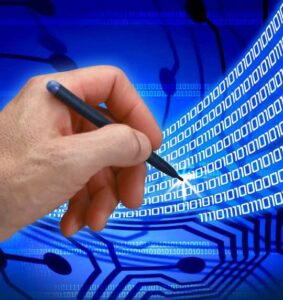It’s always entertaining to tell younger attorneys about the inefficient ways that lawyers did their jobs back in the day, without modern technology (and probably extremely boring for the younger attorneys to hear those stories). For example, as a junior attorney, I recall that email was just starting to come into common usage, and the job of the paralegal often involved early evening distributions – sending out FedEx distributions of revised drafts of documents before the 9pm overnight delivery cutoff. One aspect of current legal practice that will likely be looked at in the coming years as equally antiquated is the obtaining of manual signatures on contracts.
 This Slate Explainer has a short but informative history of the use of signatures on legal documents. Technology has made the process somewhat more streamlined (fax machine, then PDFs), but signatures remain a practical impediment to quick completion of agreements. In 2016, there are still delays when a party cannot immediately sign an agreement as a result of being, for example, traveling without access to a scanner. Attorneys with good organizational skills know to obtain and hold onto signature pages from a client who is about to travel ahead of a closing, but there is more stress and scrambling than there needs to be.
This Slate Explainer has a short but informative history of the use of signatures on legal documents. Technology has made the process somewhat more streamlined (fax machine, then PDFs), but signatures remain a practical impediment to quick completion of agreements. In 2016, there are still delays when a party cannot immediately sign an agreement as a result of being, for example, traveling without access to a scanner. Attorneys with good organizational skills know to obtain and hold onto signature pages from a client who is about to travel ahead of a closing, but there is more stress and scrambling than there needs to be.
Fortunately, the technology is improving further, as we speak, via electronic signature services like DocuSign. The federal ESIGN Act, enacted in 2000, provided broad recognition of the validity of electronic signatures, which paved the way for these types of services. They allow parties to sign agreements easily via any internet-enabled device, without a scanner or fax machine, so really the only time an agreement can’t be signed is if the signatory is on a plane and doesn’t want to spring for wi-fi or is deep in the wilderness. My clients are increasingly requesting that these services be used, and I expect them to be widely adopted in the coming years. And the coming generation of new corporate attorneys can laugh at the likes of me for having spent time chasing down manual signatures.